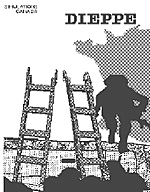
Players 2
Period WWII
Scale Operational Turn One hour
Map 550 meters each hexagon
Unit Companies, platoons, sections
Components
1 70cm x 26cm standard map
225 die-cut counters
1 half-size rule folder
1 cardboard box with beautiful artwork
Counter Manifest
44 Black/dk red Canadian Infantry
7 White/dk red Canadian Armor
10 Black/lt red British Commandos
12 Black/lt red British Paratroopers
5 White/lt red British Marine Commandos
8 White/black Allied Naval Units
67 Black/grey German Units
58 Red/black Bombardment markers
6 Red and black/white Battery markers
2 Red/white Landing Craft Group Markers
7 Black/white counters
In addition, there were 29 blank counters: 15 grey and 14 dark red.
SimCan says:
“Dieppe is a game simulation of the first landing in force on Continental Europe by the Allied Powers in World War II. The simulation has an historical and several hypothetical scenarios covering the actual and potential events at Dieppe. In all scenarios the objectives of the players are unvarying. The Allied player must try to meet the objectives of the actual operation and must do so with a minimum of losses. The German player attempt to prevent the Allied player from gaining these goals.”
The Reviewers say:
“Dieppe is a fascinating exercise in problem-solving, and covers for the first time, to my knowledge, one of WWII’s more obscure topics. Postal players will find Dieppe easily adaptable to play-by-mail, and solitary players will find a splendid solitaire game. WWII buffs will want to add this game to their collections, since it covers a new topic, and all players who enjoy a short, tense game will like Dieppe. If you fall into any of these categories, you may want to reserve a space on your shelf for Dieppe, because it is an outstanding value.” --Roy Schelper in F&M 12.
“The game is fairly complex, but the system is well conceived and well presented. Dieppe succeeds both as a game and as historical simulation, making it an excellent product.” --Jeff Petraska in F&M 65.
Comments
A Canadian game on a Canadian battle: what is more unusual? The problem with the assault on Dieppe was the unclearness of the real purpose of the operation: something too large for a raid and too small for a reconquest of Europe. The game could have had the same problem. Hopefully, the designer had the good idea to offer a lot of what-if possibilities among the different battleplans studied before the landing. These options offer special troops, naval and air support and specific victory conditions: destroy installations, study radar installations and occupy specific sites. All in all a very fine game.
Collectors Notes
The best and [almost -ed] only game on the subject. There were two editions of the game, the first in 1977, the second in 1981. Boone quotes low, high and average prices of 5/31/11.65 at auction and 10/30/18.25 for sale.
Errata
- Units may always move at least one hex during their first movement phase regardless of terrain cost unless specifically prohibited by some other rule.
- On the map Petit Appeville (hex 2226) should be a white background hex.
Steve Newberg says:
In the beginning we wanted to do one game in three on a Canadian topic, with the strange notion of building a domestic market. This was before I found out that Canadians do not buy Canadian products due to some inferiority complex problems. Dieppe, as one of Canada’s keystone solo operations in WWII was an obvious topic. It actually made a pretty good game, even if the real event was a major mess. For the second edition we made a prettier map, better counters, and added an excellent Kula cover, but made no other changes.
Back to Simulacrum Vol. 3 No. 2 Table of Contents
Back to Simulacrum List of Issues
Back to MagWeb Master Magazine List
© Copyright 2001 by Steambubble Graphics
This article appears in MagWeb (Magazine Web) on the Internet World Wide Web. Other military history articles and gaming articles are available at http://www.magweb.com